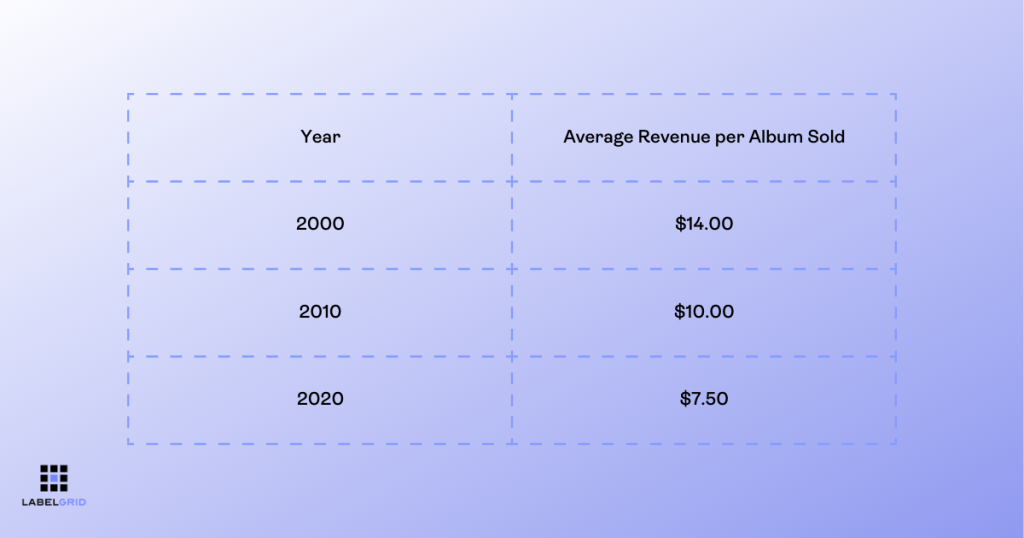Think about the last time you bought a CD or vinyl record. Has it been a while? You’re not alone. The music industry has undergone seismic shifts in the past few decades, with digital streaming and downloads becoming the norm. Record labels, once giants in the field, have had to adapt quickly to stay relevant. Today’s landscape presents unique hurdles they must grapple with.
For starters, there’s the matter of sheer competition. In an age where anyone with a laptop can produce and distribute music, record labels are no longer gatekeepers of who gets heard and who doesn’t. This democratization is excellent for artists but leaves labels scrambling to stand out from the crowd.
Then there’s technology itself – both a blessing and a curse for modern record companies. While digital platforms give them unprecedented reach across global markets, they must also constantly keep up-to-date with changing consumer preferences and emergent technologies like AI-generated music or virtual concerts.
As you scroll into this article, ask yourself: How are these challenges reshaping what we understand by record labels? Are they still crucial players in today’s music industry? And if so, how do they continue to add value in an ever-evolving landscape? Now, let’s strike up a conversation on these heady questions!
Understanding the Modern Music Industry
Identifying Key Challenges
So, you’re passionate about music and dream of making it big in the industry. This journey comes with its unique set of challenges that are amplified by our modern world’s complexities. Let’s break them down:
- Monetizing Digital Content: With streaming services like Spotify, Apple Music, and Tidal dominating the market, artists now struggle to make substantial revenue off their music alone.
- Saturation of Talent: The digital age has given anyone with an internet connection a shot at fame. While this is fantastic for diversity and creativity, standing out from the crowd is more complex than ever.
- Digital Piracy: Even though illegal downloading isn’t as prevalent as it once was, piracy continues to rob artists and labels of significant revenue.
Role of Digitalization: Impact on Today’s Record Labels
Music isn’t just about CDs or vinyl anymore; it’s gone digital! But what does this mean for record labels?
The shift towards digital platforms has brought both opportunities and challenges for record labels. On one hand, you have access to a global audience without geographical limitations. On the other hand, gaining visibility in a crowded online space can be an uphill battle.
With top players like Universal Music Group, Sony Music, and Warner Music Group investing heavily in digital strategies – think playlists and social media campaigns – being digitally savvy is no longer optional; it’s crucial!
Surviving in the Music Business: Strategies for Modern Labels
We’ve discussed some obstacles modern record labels face, but how do they navigate this complex landscape?
- Adopting Technology: Record labels today need to understand how technologies such as AI can help streamline operations or create personalized marketing campaigns.
- Building Brand Identity: To stand out from competitors, labels must create a strong brand. This includes defining their unique selling proposition and communicating it effectively to the audience.
- Fostering Artist Relationships: An artist is more than just a profit-generator for the label. By nurturing relationships with artists, labels can ensure long-term success and loyalty.
The music industry is an ever-evolving scene that’s influenced by technological advancements, cultural shifts, and consumer behavior changes. However challenging as it may seem, many have found ways to thrive amidst these complexities. As you embark on your journey in this exciting industry, remember to stay adaptable and embrace change – after all, that’s what music is all about!
The Evolution of Record Labels
The Shift from Physical to Digital: A Record Label’s Perspective
You’ve probably noticed how music isn’t quite the same anymore. It’s not just about the genre trends or the rise of new artists. What has fundamentally changed is how we consume music. Remember when owning a record (for you youngsters, it’s the thin round plastic thing!) was an exciting event? When you’d rush home to play it on your turntable, savoring every note as if it were a rare treat? Well, those days are largely behind us now, and the shift from physical to digital formats has profoundly affected record labels.
In the past, record labels made most of their profits by selling physical copies of albums – vinyl records, cassette tapes, CDs. But with the advent of digital platforms like iTunes and Spotify, there’s been a dramatic drop in physical sales. This transition hasn’t been easy for many labels because digital sales don’t generate nearly as much revenue per unit sold.
Consider this: In 2001, global CD sales peaked at $13.2 billion, while in 2022, total revenues from streaming services alone accounted for $17.5 billion – almost triple what they were just four years prior!
However, it’s not all doom and gloom for modern record labels. With digital distribution comes opportunities to reach wider audiences globally without worrying about manufacturing costs or logistics associated with shipping physical products.
Overcoming the Hurdle: Modern Record Labels and Copyright Issues
Now let’s talk about another challenge faced by today’s record labels – copyright issues related to online content-sharing platforms such as YouTube or SoundCloud, where anyone can upload music tracks without necessarily having legal rights over them.
The problem here is twofold:
- Artists could lose potential royalties when their work gets shared freely without permission.
- Record labels may be unable to fully monetize their catalogues due to widespread illegal distribution.
To combat this, record labels have had to adapt by employing teams dedicated to protecting their artists’ intellectual property rights. They invest in technology that can identify copyrighted music on these platforms and issue take-down notices or negotiate licensing deals so they can earn revenue from those streams.
The New Challenge for Today’s Record Labels
Finally, we arrive at one of the most significant current challenges for record labels – the streaming era. With services like Spotify, Apple Music, and Tidal dominating the music industry landscape, it’s a new ball game for record labels.
Here’s why it’s tricky: Subscription-based streaming platforms pay royalties based on an artist’s share of total plays. That means lesser-known artists often receive minuscule payouts compared to established acts garnering millions of streams.
This shift has necessitated rethinking strategies to optimize streaming revenues for record labels traditionally relying on album sales and physical distribution as major income sources. This could include focusing on playlist placements or releasing more singles frequently instead of waiting for full-length albums – all while balancing the need to respect artistic integrity and maintain strong relationships with their signed musicians.
While modern record labels face numerous challenges brought about by digital disruption – from copyright issues to navigating the streaming era – there are opportunities for those able to innovate and adapt swiftly in this ever-evolving industry landscape.
Digitalization and Its Impact on Record Labels
Understanding the Digital Transformation in Music Industry
The music industry’s landscape has dramatically transformed with the advent of digital technology. It’s as if you’ve traded your old vinyl records for a sleek new streaming service. This shift means artists can now distribute their music globally at the click of a button, reaching fans they never could.
Digitalization has also democratized access to music production tools. Imagine you’re cooking dinner. Previously, you needed expensive ingredients and specialized knowledge to make anything beyond a basic dish. But now, easy-to-use software is like having an all-in-one kitchen tool that lets even amateur cooks whip up gourmet meals.
But there’s more to it than meets the eye.
Digitalization: A Double-Edged Sword for Record Labels
While digitalization brings opportunities, it also presents challenges for record labels – kind of like trying to catch a slippery fish with bare hands. As artists gain more independence through DIY platforms, record labels have seen their traditional role as gatekeepers diminish.
Also, piracy is another concern exacerbated by digital technology. Picture this: You bake a delicious cake only to have someone sneak into your kitchen and gobble up slices without paying or even asking permission! That’s what online piracy feels like for many in the music business.
Yet it doesn’t spell doom and gloom entirely for record labels.
The Future of Record Labels in the Wake of Digitalization
Even though digital disruption may seem threatening initially – think about how daunting it would be if you suddenly had to navigate through unknown terrain – there are ways record labels can adapt and thrive in this new environment. They need to redefine their roles akin to switching gears from being just drivers steering artists’ careers towards becoming co-pilots charting out strategies together with musicians.
They can offer value-added services such as branding expertise or network connections that independent artists might find harder to attain on their own. It’s like being at a bustling party where everyone is trying to shout above the noise; having someone with a loudspeaker (the record label) can help you get heard better.
Ultimately, digitalization isn’t a villain out to destroy record labels. Instead, it’s an evolving stage on which they must learn new dance moves to keep up with the rhythm. By embracing change and leveraging their strengths, record labels can continue playing an instrumental role in shaping our vibrant music industry.
Challenges in Artist Discovery and Development
Overcoming Artist Discovery Challenges
In this digital age, artist discovery is one of the major challenges that record labels face. With platforms like YouTube, SoundCloud, and Bandcamp allowing anyone to upload music, it’s become increasingly difficult for record labels to sift through the noise and find talented artists. Not only that but with so many musicians going the independent route these days, convincing them of a label’s value can be daunting.
Yet there are ways to overcome these hurdles. Record labels need to think outside the box when discovering new talent. This might mean scouting at local gigs or using data analytics tools that can identify emerging trends before they reach mainstream popularity. Additionally, positioning themselves as allies rather than adversaries for indie artists can help build trust and foster fruitful partnerships.
Strategies for Effective Talent Development Amidst Industry Changes
However, finding talent isn’t just about identifying who’s next on the charts – it’s also about developing that talent once it’s been discovered. In today’s rapidly changing music industry landscape marked by digitalization and shifting consumer preferences, old-school methods of artist development might not cut it anymore.
Record labels must adapt their strategies accordingly. For instance, social media management should now be part of an artist’s development program since online presence has become crucial in building a fanbase. Helping artists understand their brand identity while leaving room for organic growth is another key aspect – no one wants cookie-cutter musicians who all sound alike!
The Impact of Streaming Services on Artist Development
Streaming services have radically changed how we consume music and how artists are developed. While streaming has increased accessibility leading to potential global exposure even for niche artists, it also presents its own challenges.
The abundance of music available means listeners often have shorter attention spans, with songs being skipped within seconds if they don’t captivate immediately. This constant pressure to produce ‘hits’ can stifle an artist’s creative evolution. Also, the relatively low royalties paid by these platforms can be disheartening for artists who have put their heart and soul into their work.
Record labels need to navigate this tricky terrain carefully – promoting artists in a way that ensures they get noticed amidst the flood of music without compromising on their unique sound or vision. They also need to advocate for fair compensation from streaming services, ensuring that musicians can sustain themselves financially while they craft their art.
In conclusion, the artist discovery and development world is fraught with challenges in today’s digital reality. However, with strategic adaptability and unwavering dedication to nurturing talent, record labels can continue playing a pivotal role in shaping the future of music.
Financial Pressure Faced by Modern Record Labels
Record labels today are up against a slew of financial challenges. These range from the struggle to generate revenue to grappling with the economic impact of digitization.
Unpacking the Financial Struggles of Modern Record Labels
Today’s record labels face an uphill battle regarding financial stability. They’re combating increasing costs for production and promotion while dealing with shrinking margins from music sales. This pressure is compounded by the growing prevalence of illegal downloads and streaming services that offer pennies on the dollar for each song played.
The numbers paint a grim picture:

This dip in album revenue presents a sobering reality for modern record labels, signaling a need for creative solutions to stay afloat.
Revenue Generation: A Major Challenge for Today’s Record Labels
In addition to sinking album sales, generating revenue has become an increasing challenge in other areas as well:
- Concert Ticket Sales: Concerts have traditionally been cash cows (when done right, Fyre Festival?) for musicians and their labels alike. However, this reliable income stream can dry up, with live events being put on hold due to global circumstances such as pandemics or political unrest.
- Merchandising: While merchandising can provide additional income, it typically demands upfront investment, which doesn’t always pay off. However, if you’re savvy, places like Printful can help keep initial costs low.
These roadblocks force record labels to stretch every dollar and think outside the box when planning their business strategies.
The Economic Impact of Digital Transition on Record Labels
The transition from physical albums to digital music has also hit record label wallets hard. While there are fewer physical production costs involved in releasing digital tracks, companies are losing out on traditional album sales profits they once relied upon.
With platforms like Spotify and Apple Music dominating the market, record labels are often left with only half the revenue. For example, in 2020, Spotify paid between $0.00331 and $0.00437 per stream to rights holders – a far cry from traditional album profit margins.
This digital revolution has necessitated a major shift in how record labels operate financially, forcing them to adapt or risk falling behind in the rapidly evolving music industry.
Facing these financial pressures is no easy task. However, by understanding these challenges and strategizing accordingly, modern record labels can navigate this new terrain and continue to bring incredible music to our ears.
Legal Issues Surrounding Intellectual Property Rights
When it comes to the music industry, understanding intellectual property rights can feel like trying to navigate a complex maze. Let’s break it down.
Understanding Intellectual Property Rights in the Music Industry
Imagine you’re an artist who just finished painting a masterpiece. You’d want to make sure no one else claims your work as their own, right? The same principle applies in the music industry.
Intellectual property rights are legal protections for creators and their creative works, from songs and lyrics to album covers and music videos. In a nutshell, they prevent others from using, copying, or profiting from your work without permission.
When these rights aren’t respected, conflicts arise. For example:
- One common issue is copyright infringement—when someone uses part of another artist’s work without permission.
- Plagiarism is another concern—it’s when an artist copies another’s creation and passes it off as original work.
- There’s also piracy—the unauthorized reproduction or distribution of copyrighted work.
Modern Record Labels: Legal Issues in Intellectual Property
Modern record labels face quite a few challenges when dealing with intellectual property rights. It’s like being at a concert where everyone wants to get to the front row – but not everyone plays fair.
Firstly, managing multiple copyrights for every song released is challenging. This includes the composition (the melody and lyrics) owned by the songwriter(s), and then there’s the sound recording copyright which belongs to whoever records that specific version of the song – usually the record label itself.
Another hurdle is digital platforms—streaming services like Spotify or Apple Music have made it easy for artists to distribute their music globally, but this has also led to increased risks of piracy and unauthorized use of music on other platforms, such as YouTube.
Implications of Intellectual Property Laws on Today’s Record Labels
One implication is financial—record labels can lose significant revenue due to piracy and copyright infringement. For instance, in 2018 alone, the music industry lost $2.8 billion in revenue due to music piracy.
Another is legal—the risk of lawsuits for copyright infringement is high. There have been notable cases where record labels have faced hefty legal fees and damages for unauthorized use or distribution of copyrighted work.
So what does this mean for you as an aspiring musician or music enthusiast? It means understanding these complexities and challenges is crucial not just for your own protection but also so you can navigate the industry more effectively. Knowing how to protect your work and respect others’ intellectual property rights could be one key to success in this competitive landscape.
Conclusion: Overcoming Challenges for Future Success
Navigating the ocean of the music industry can be both thrilling and daunting. You’re not alone, though. Many have sailed these waters before, braving the tides, currents, and storms to make their mark in this exciting realm.
One key point you’ve got to remember is that complexity doesn’t necessarily mean impossibility. Think about it like trying to assemble a puzzle. It’s complicated at first glance, but with patience, focus, and a bit of strategy – each piece finds its rightful place.
Misconceptions? They come with the territory when you’re new to the game. One common mistake is thinking that record labels are your only ticket to success. That’s old school! Today’s digital age offers countless independent avenues for budding artists like yourself.
Now let’s talk roles and strategies. Whether you see yourself as an artist or a manager dictates how you approach your journey in this industry. As an artist, your focus lies in perfecting your craft and creating unique sounds that resonate with audiences worldwide. On the other hand, as a manager, your role requires strategic planning skills to market talent effectively.
Staying current is essential too! The music world changes fast; what was hot yesterday might not be tomorrow. So tune into trends regularly – whether through social media platforms or online blogs – and don’t shy away from adapting them into your own style or methods.
So there you have it! A glimpse into overcoming challenges within modern record labels for future success awaits if you dare brave these waves head-on! Remember – every great musician started somewhere like where you are right now.





